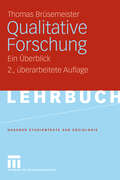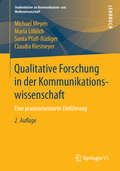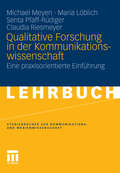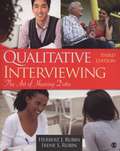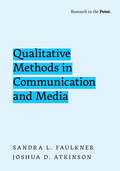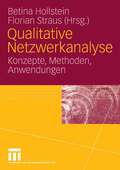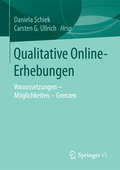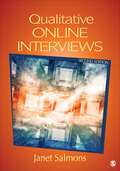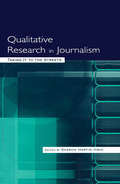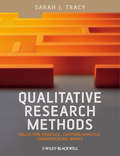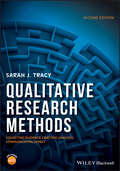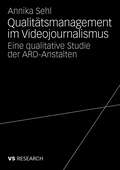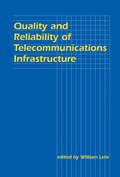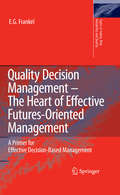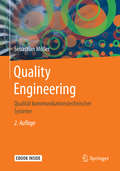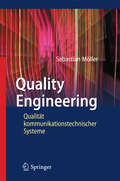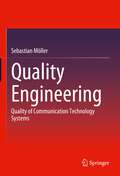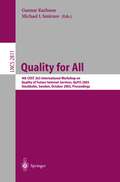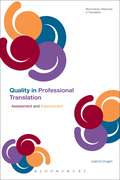- Table View
- List View
Qualitative Forschung: Ein Überblick (Studientexte zur Soziologie)
by Thomas BrüsemeisterDieses Buch stellt Grundzüge von fünf Verfahren der qualitativen Forschung vergleichend vor: · qualitative Einzelfallstudien, · narratives Interview, · Grounded Theory, · ethnomethodologische Konversationsanalyse · und objektive Hermeneutik. Die Darstellung beginnt mit qualitativen Einzelfallstudien, bei denen Beschreibungen von Daten im Mittelpunkt stehen. Am Ende werden Methoden diskutiert, die ihren Gegenstand stärker theoretisch deuten. Alle Verfahren werden weitgehend aus Sicht der Anwendungspraxis geschildert.
Qualitative Forschung in der Kommunikationswissenschaft: Eine Praxisorientierte Einführung (Studienbücher Zur Kommunikations- Und Medienwissenschaft Ser.)
by Michael Meyen Maria Löblich Senta Pfaff-Rüdiger Claudia RiesmeyerDas Lehrbuch versteht sich als Anleitung zum Forschen: Wo lassen sich qualitative Methoden in der Kommunikationswissenschaft gewinnbringend einsetzen? Wie muss eine Untersuchung aufgebaut werden und wie werden Befragte oder Texte so ausgewählt, dass man am Ende verallgemeinern kann? Wie konstruiere ich einen Interview-Leitfaden und was muss ich beachten, damit eine Gruppendiskussion oder eine Beobachtung wirklich funktionieren? Befrage ich offline oder online und was kann ich tun, damit ich nicht in einem Materialberg untergehe? Mit zahlreichen Beispielen aus der Forschungspraxis.
Qualitative Forschung in der Kommunikationswissenschaft: Eine praxisorientierte Einführung (Studienbücher zur Kommunikations- und Medienwissenschaft)
by Michael Meyen Maria Löblich Senta Pfaff-Rüdiger Claudia RiesmeyerDas Lehrbuch versteht sich als Anleitung zum Forschen: Wo lassen sich qualitative Methoden in der Kommunikationswissenschaft gewinnbringend einsetzen? Wie muss eine Untersuchung aufgebaut werden und wie werden Befragte oder Texte so ausgewählt, dass man am Ende verallgemeinern kann? Wie konstruiere ich einen Interview-Leitfaden und was muss ich beachten, damit eine Gruppendiskussion oder eine Beobachtung wirklich funktionieren? Befrage ich offline oder online und was kann ich tun, damit ich nicht in einem Materialberg untergehe? Mit zahlreichen Beispielen aus der Forschungspraxis.
Qualitative Interviewing: The Art Of Hearing Data (PDF)
by Herbert Rubin Irene RubinThe book describes in-depth qualitative interviewing from the very beginning to last step, from its underlying philosophy and assumptions to project design, analysis and write up. In responsive interviewing, the stages of research-design, data gathering, and analysis-are intimately linked. Researchers perform analysis throughout their projects, not just at the end, so that as they learn more, they can modify both the research problem they are exploring and the questions they ask. The book assumes no prior knowledge or experience, and the authors′ tone is conversational, revealing that interviewers can make mistakes, recover from them and still obtain rich and meaningful information.
Qualitative Methods in Communication and Media (Research to the Point)
by Sandra L. Faulkner Joshua D. AtkinsonQualitative Methods in Media and Communication offers a learning-centered guide to designing, conducting, and evaluating qualitative communication and media research methods. Drawing upon years of teaching qualitative research methods, Sandra L. Faulkner and Joshua D. Atkinson introduce and unpack qualitative communication research method design, analysis, representation, writing, and evaluation using extended examples and clear discussion. The authors use key terms, extended examples, discussion questions, student-tested writing and research activities, examples of student work and questions, and suggested resources to help readers design, do, and analyze qualitative research. As a textbook, its pedagogical goals for the student include: (1) becoming a critical reader of research studies by understanding the epistemologies and methodological assumptions used by researchers, (2) learning the various methods, strategies, and approaches for doing qualitative research, (3) developing a strong basic vocabulary and understanding of concepts relating to qualitative and humanistic research methods, (4) understanding special concerns related to particular research methods, and (5) designing, executing, and representing original qualitative research projects. With numerous elements intended to engage students and enrich the learning process, the book provides examples of how to do qualitative and critical analyses, including arts-based and media and textual analyses to understand, describe, and query communication and media research in a variety of communication areas. There is also an extensive discussion of ethics in qualitative research and spotlights with renowned researchers on hot topics in qualitative research.
Qualitative Methods in Communication and Media (Research to the Point)
by Sandra L. Faulkner Joshua D. AtkinsonQualitative Methods in Media and Communication offers a learning-centered guide to designing, conducting, and evaluating qualitative communication and media research methods. Drawing upon years of teaching qualitative research methods, Sandra L. Faulkner and Joshua D. Atkinson introduce and unpack qualitative communication research method design, analysis, representation, writing, and evaluation using extended examples and clear discussion. The authors use key terms, extended examples, discussion questions, student-tested writing and research activities, examples of student work and questions, and suggested resources to help readers design, do, and analyze qualitative research. As a textbook, its pedagogical goals for the student include: (1) becoming a critical reader of research studies by understanding the epistemologies and methodological assumptions used by researchers, (2) learning the various methods, strategies, and approaches for doing qualitative research, (3) developing a strong basic vocabulary and understanding of concepts relating to qualitative and humanistic research methods, (4) understanding special concerns related to particular research methods, and (5) designing, executing, and representing original qualitative research projects. With numerous elements intended to engage students and enrich the learning process, the book provides examples of how to do qualitative and critical analyses, including arts-based and media and textual analyses to understand, describe, and query communication and media research in a variety of communication areas. There is also an extensive discussion of ethics in qualitative research and spotlights with renowned researchers on hot topics in qualitative research.
Qualitative Netzwerkanalyse: Konzepte, Methoden, Anwendungen
by Betina Hollstein Florian StrausQualitative Netzwerkanalysen finden derzeit Eingang in unterschiedlichste Forschungsfelder. Das Handbuch bietet erstmalig eine Systematisierung der Forschungsstrategien und Methoden, mit denen qualitative Netzwerkanalysen durchgeführt werden können. Neben systematisierenden und konzeptionellen Beiträgen werden anhand von exemplarischen Studien methodische Designs qualitativer Netzwerkanalysen vorgestellt und grundlegende Probleme der Durchführung, Erhebung und Auswertung von qualitativen Netzwerkstudien erörtert.
Qualitative Online-Erhebungen: Voraussetzungen - Möglichkeiten - Grenzen
by Daniela Schiek Carsten G. UllrichQualitative Online-Forschung wird zwar immer häufiger durchgeführt, aber nur selten methodologisch reflektiert: Welche Funktionen und Merkmale haben Online-Kommunikationen und wie können diese erkenntnisgewinnend für die Qualitative Forschung genutzt werden? Diese und weitere Fragen sind Gegenstand dieses Bandes. Im Vordergrund stehen dabei (reaktive) Verfahren der qualitativen Datenerhebung wie Interviews und Gruppendiskussionen.
Qualitative Online Interviews: Strategies, Design, And Skills
by Janet SalmonsThe Second Edition of Qualitative Online Interviews provides researchers the guidance they need to extend the reach of their studies beyond physical boundaries. Focusing on designing, conducting, and assessing data drawn from online interviews as well as from observations, materials, and artifacts collected online, the book emphasizes the use of in-depth interviews in qualitative research or mixed-methods designs. Written in an easy-to-read manner, the thorough Second Edition offers the practical information and scholarly foundations needed to make thoughtful decisions in technology-infused research.
Qualitative Research in Journalism: Taking It to the Streets
by Sharon Hartin IorioThis volume highlights the integration of qualitative research methods into traditional journalism, offering new ways of expanding and enhancing news coverage. Designed for readers without prior experience in social science research, this collection presents a wide variety of qualitative techniques and their applications in journalistic practice. The work brings together contributions from professional journalists and journalism scholars who are highly experienced in conducting qualitative research. These experts demonstrate how valid, reliable qualitative procedures can be used to increase coverage and offer new insights. Written in a straightforward, reader-friendly style, features in this volume include: *real-world examples from contemporary newsrooms and interviews with practicing journalists who use the techniques of qualitative research in reporting; *a rationale for the use of qualitative methods in journalism, with an illustration of how various qualitative methods tie together; *step-by-step instructions for applying each methodology; *a solid foundation for understanding the history and theory behind qualitative research and its usefulness in journalism; *chapters on pairing qualitative and quantitative methods in journalism and on detailing partnerships between academics and professional journalists to facilitate newsroom research and reporting; and *a discussion of "objectivity" in qualitative research and in journalism that offers an ethic for journalists of today. The methodologies covered here include oral and life histories, textual analysis, focused interviews, ethnographies, focus groups, and case studies. In addition, a recently developed technique, civic mapping, is presented as a qualitative tool for reporting. Qualitative Research in Journalism is an indispensable resource for current and future journalists interested in enhancing their coverage of the news.
Qualitative Research in Journalism: Taking It to the Streets
by Sharon Hartin IorioThis volume highlights the integration of qualitative research methods into traditional journalism, offering new ways of expanding and enhancing news coverage. Designed for readers without prior experience in social science research, this collection presents a wide variety of qualitative techniques and their applications in journalistic practice. The work brings together contributions from professional journalists and journalism scholars who are highly experienced in conducting qualitative research. These experts demonstrate how valid, reliable qualitative procedures can be used to increase coverage and offer new insights. Written in a straightforward, reader-friendly style, features in this volume include: *real-world examples from contemporary newsrooms and interviews with practicing journalists who use the techniques of qualitative research in reporting; *a rationale for the use of qualitative methods in journalism, with an illustration of how various qualitative methods tie together; *step-by-step instructions for applying each methodology; *a solid foundation for understanding the history and theory behind qualitative research and its usefulness in journalism; *chapters on pairing qualitative and quantitative methods in journalism and on detailing partnerships between academics and professional journalists to facilitate newsroom research and reporting; and *a discussion of "objectivity" in qualitative research and in journalism that offers an ethic for journalists of today. The methodologies covered here include oral and life histories, textual analysis, focused interviews, ethnographies, focus groups, and case studies. In addition, a recently developed technique, civic mapping, is presented as a qualitative tool for reporting. Qualitative Research in Journalism is an indispensable resource for current and future journalists interested in enhancing their coverage of the news.
Qualitative Research Methods: Collecting Evidence, Crafting Analysis, Communicating Impact
by Sarah J. TracyQualitative Research Methods is a comprehensive, all-inclusive resource for the theory and practice of qualitative/ethnographic research methodology. Serves as a “how-to” guide for qualitative/ethnographic research, detailing how to design a project, conduct interviews and focus groups, interpret and analyze data, and represent it in a compelling manner Demonstrates how qualitative data can be systematically utilized to address pressing personal, organizational, and social problems Written in an engaging style, with in-depth examples from the author’s own practice Comprehensive companion website includes sample syllabi, lesson plans, a list of helpful website links, test bank and exam review materials, and exercises and worksheets, available upon publication at www.wiley.com/go/tracy
Qualitative Research Methods: Collecting Evidence, Crafting Analysis, Communicating Impact
by Sarah J. TracyThe definitive step-by step resource for qualitative and ethnographic research Qualitative Research Methods: Collecting Evidence, Crafting Analysis, Communicating Impact is a comprehensive guide on both the theoretical foundations and practical application of qualitative methodology. Adopting a phronetic-iterative approach, this foundational book leads readers through the chronological progression of a qualitative research project, from designing a study and collecting and analyzing data to developing theories and effectively communicating the results—allowing readers to employ qualitative methods in their projects as they follow each chapter. Coverage of topics such as qualitative theories, ethics, sampling, interview techniques, qualitative quality, and advice on practical fieldwork provides clear and concise guidance on how to design and conduct sound research projects. Easy-to-follow instructions on iterative qualitative data analysis explain how to organize, code, interpret, make claims, and build theory. Throughout, the author offers her own backstage stories about fieldwork, analysis, drafting, writing, and publishing, revealing the emotional and humorous aspects of practicing qualitative methods. Now in its second edition, this thorough and informative text includes new and expanded sections on topics including post-qualitative research, phenomenology, textual analysis and cultural studies, gaining access to elite and difficult to access populations, on persuasive writing, novel interviewing approaches, and more. Numerous examples, case studies, activities, and discussion questions have been updated to reflect current research and ensure contemporary relevance. Written in an engaging and accessible narrative style by an acclaimed scholar and researcher in the field Offers new and updated examples of coding and qualitative analysis, full-color photos and illustrations, and a companion instructor website Synthesizes the most up-to-date multidisciplinary literature on qualitative research methods including seven main approaches to qualitative inquiry: grounded theory, case study, ethnography, phenomenology, narrative and autoethnography, participatory action research, and arts-based research Presents innovative qualitative data collection methods and modern representation strategies, such as virtual ethnography, photo-voice, and mobile interviewing Qualitative Research Methods: Collecting Evidence, Crafting Analysis, Communicating Impact is an ideal resource for undergraduate and graduate students, instructors, and faculty across multiple disciplines including the social sciences, healthcare, education, management, and the humanities, and for practitioners seeking expert guidance on practical qualitative methods.
Qualitative Research Methods: Collecting Evidence, Crafting Analysis, Communicating Impact
by Sarah J. TracyThe definitive step-by step resource for qualitative and ethnographic research Qualitative Research Methods: Collecting Evidence, Crafting Analysis, Communicating Impact is a comprehensive guide on both the theoretical foundations and practical application of qualitative methodology. Adopting a phronetic-iterative approach, this foundational book leads readers through the chronological progression of a qualitative research project, from designing a study and collecting and analyzing data to developing theories and effectively communicating the results—allowing readers to employ qualitative methods in their projects as they follow each chapter. Coverage of topics such as qualitative theories, ethics, sampling, interview techniques, qualitative quality, and advice on practical fieldwork provides clear and concise guidance on how to design and conduct sound research projects. Easy-to-follow instructions on iterative qualitative data analysis explain how to organize, code, interpret, make claims, and build theory. Throughout, the author offers her own backstage stories about fieldwork, analysis, drafting, writing, and publishing, revealing the emotional and humorous aspects of practicing qualitative methods. Now in its second edition, this thorough and informative text includes new and expanded sections on topics including post-qualitative research, phenomenology, textual analysis and cultural studies, gaining access to elite and difficult to access populations, on persuasive writing, novel interviewing approaches, and more. Numerous examples, case studies, activities, and discussion questions have been updated to reflect current research and ensure contemporary relevance. Written in an engaging and accessible narrative style by an acclaimed scholar and researcher in the field Offers new and updated examples of coding and qualitative analysis, full-color photos and illustrations, and a companion instructor website Synthesizes the most up-to-date multidisciplinary literature on qualitative research methods including seven main approaches to qualitative inquiry: grounded theory, case study, ethnography, phenomenology, narrative and autoethnography, participatory action research, and arts-based research Presents innovative qualitative data collection methods and modern representation strategies, such as virtual ethnography, photo-voice, and mobile interviewing Qualitative Research Methods: Collecting Evidence, Crafting Analysis, Communicating Impact is an ideal resource for undergraduate and graduate students, instructors, and faculty across multiple disciplines including the social sciences, healthcare, education, management, and the humanities, and for practitioners seeking expert guidance on practical qualitative methods.
Qualitative Research Methods: Collecting Evidence, Crafting Analysis, Communicating Impact
by Sarah J. TracyQualitative Research Methods is a comprehensive, all-inclusive resource for the theory and practice of qualitative/ethnographic research methodology. Serves as a “how-to” guide for qualitative/ethnographic research, detailing how to design a project, conduct interviews and focus groups, interpret and analyze data, and represent it in a compelling manner Demonstrates how qualitative data can be systematically utilized to address pressing personal, organizational, and social problems Written in an engaging style, with in-depth examples from the author’s own practice Comprehensive companion website includes sample syllabi, lesson plans, a list of helpful website links, test bank and exam review materials, and exercises and worksheets, available upon publication at www.wiley.com/go/tracy
Qualitätsmanagement im Videojournalismus: Eine qualitative Studie der ARD-Anstalten
by Annika SehlIst Videojournalismus lediglich ein Kostensparmodell, das den Arbeitsdruck erhöht und die Qualität verringert oder ist er die Arbeitsweise der Zukunft? Annika Sehl untersucht die Strategien des redaktionellen Qualitätsmanagements, mit denen die ARD-Anstalten der neuen Produktionsweise begegnen.
Quality and Reliability of Telecommunications Infrastructure: Quality And Reliability Of Telecommunications Infrastructure (LEA Telecommunications Series)
by William LehrIn the last decade, the technology, regulation, and industry structure of our information infrastructure (telephone services, cable and broadcast television, and myriad new data and information services) have changed dramatically. Since the break-up of AT&T's Bell System monopoly, telephone services in the United States are no longer purchased from a single firm. Advances in fiber optics, wireless communications and software-controlled switching are changing how communication services are provided. As the global economy grows more dependent on a hybrid mix of interconnected networks, public officials in the US and abroad are relinquishing control of the market. All of these changes are affecting the quality and reliability of the telecommunications infrastructure, but informed discussions of the public policy and economic issues are scarce. Deregulation and increased competition have lowered prices, but have service quality and reliability suffered? Do advanced network technologies which make it possible to offer a dizzying array of new services increase vulnerability to system-wide failures? Who should or is likely to bear the costs of increased -- or decreased -- service quality? This volume tackles the economic and public policy issues raised by these difficult questions for an audience of industry executives, scholars, and policymakers. Leading scholars and analysts examine such issues as the effects of network ownership on incentives to invest in quality improvements and/or strategies for quality-differentiated pricing in tomorrow's broadband, integrated networks. They analyze the quality of current telecommunications networks and the impact of re-regulation on cable television quality. The contributions range from new microeconomic theory to new empirical research. As such, the volume makes a valuable contribution to the public debate on network quality and reliability. It will be useful both as an introduction to newcomers and as a resource for more experienced researchers. As regulatory, industry and national barriers to integrated communications fall, these issues are likely to become even more important. The research presented here provides a solid foundation for further discussion.
Quality and Reliability of Telecommunications Infrastructure (LEA Telecommunications Series)
by William H. LehrIn the last decade, the technology, regulation, and industry structure of our information infrastructure (telephone services, cable and broadcast television, and myriad new data and information services) have changed dramatically. Since the break-up of AT&T's Bell System monopoly, telephone services in the United States are no longer purchased from a single firm. Advances in fiber optics, wireless communications and software-controlled switching are changing how communication services are provided. As the global economy grows more dependent on a hybrid mix of interconnected networks, public officials in the US and abroad are relinquishing control of the market. All of these changes are affecting the quality and reliability of the telecommunications infrastructure, but informed discussions of the public policy and economic issues are scarce. Deregulation and increased competition have lowered prices, but have service quality and reliability suffered? Do advanced network technologies which make it possible to offer a dizzying array of new services increase vulnerability to system-wide failures? Who should or is likely to bear the costs of increased -- or decreased -- service quality? This volume tackles the economic and public policy issues raised by these difficult questions for an audience of industry executives, scholars, and policymakers. Leading scholars and analysts examine such issues as the effects of network ownership on incentives to invest in quality improvements and/or strategies for quality-differentiated pricing in tomorrow's broadband, integrated networks. They analyze the quality of current telecommunications networks and the impact of re-regulation on cable television quality. The contributions range from new microeconomic theory to new empirical research. As such, the volume makes a valuable contribution to the public debate on network quality and reliability. It will be useful both as an introduction to newcomers and as a resource for more experienced researchers. As regulatory, industry and national barriers to integrated communications fall, these issues are likely to become even more important. The research presented here provides a solid foundation for further discussion.
Quality Decision Management -The Heart of Effective Futures-Oriented Management: A Primer for Effective Decision-Based Management (Topics in Safety, Risk, Reliability and Quality #14)
by E.G. FrankelOver the years I have worked with or consulted for many managers throughout the world at all levels of industry and government. I have seen who succeeded, achieved goals, and made progress, and who failed or crashed. I have studied their methods of operation and their decision-making approach, as well as the range of people involved in the decision-making. I similarly personally managed large industrial and service organizations and their operations, and found that to succeed and have a content team of collaborators, decision-making had to be joint and delegated to the lowest competent and informed level. Using this approach not only improved the performance of the organization or firm, but also resulted in a more content, professional, cooperative, happy, and competent workforce. In general, people like to assume responsibility, particularly of functions with which they are intimately familiar. They enjoy the role of de- sion-maker and the use of their knowledge and experience in guiding their and related work. Delegation of decision-making not only infuses pride and conte- ment but also assures more informed, timely, and effective implementation of de- sions. It also adds to worker training and education as workers inquire, develop information and use of their own experience in improving their decision-making. Worker pride and feeling of control and involvement lead to contentment and s- isfaction which, in return, pays dividends in worker productivity, morale, retention, and resulting low turnover.
Quality Engineering: Qualität kommunikationstechnischer Systeme
by Sebastian MöllerDer Begriff der Qualität und der Gebrauchstauglichkeit hat in der Informations- und Kommunikationstechnik sowie der Informatik eine herausragende Bedeutung. Der Autor führt in diese Thematik ein, indem er zunächst die Fachbegriffe und die Grundlagen der Psychophysik und Psychometrie erläutert. Darauf aufbauend wird der Kreislauf einer menschenorientierten Systementwicklung vorgestellt. Die Messung und Vorhersage von Qualität und Gebrauchstauglichkeit wird anhand von Beispielen veranschaulicht, u. a. für Sprach- und multimodale Dialogsysteme.
Quality Engineering: Qualität kommunikationstechnischer Systeme
by Sebastian MöllerDer Begriff der Qualität und der Gebrauchstauglichkeit hat in der Informations- und Kommunikationstechnik sowie der Informatik eine herausragende Bedeutung. Der Autor führt in diese Thematik ein, indem er zunächst die Fachbegriffe und die Grundlagen der Psychophysik und Psychometrie erläutert. Darauf aufbauend wird der Kreislauf einer menschenorientierten Systementwicklung vorgestellt. Die Messung und Vorhersage von Qualität und Gebrauchstauglichkeit wird anhand von Beispielen veranschaulicht, u. a. für Sprach- und multimodale Dialogsysteme.
Quality Engineering: Quality of Communication Technology Systems
by Sebastian MöllerDer Begriff der Qualität und der Gebrauchstauglichkeit hat in der Informations- und Kommunikationstechnik sowie der Informatik eine herausragende Bedeutung. Der Autor führt in diese Thematik ein, indem er zunächst die Fachbegriffe und die Grundlagen der Psychophysik und Psychometrie erläutert. Darauf aufbauend wird der Kreislauf einer menschenorientierten Systementwicklung vorgestellt. Die Messung und Vorhersage von Qualität und Gebrauchstauglichkeit wird anhand von Beispielen veranschaulicht, u. a. für Sprach- und multimodale Dialogsysteme.
Quality for All: 4th COST 263 International Workshop on Quality of Future Internet Services, QoFIS 2003, Stockholm, Sweden, October 1-2, 2003, Proceedings (Lecture Notes in Computer Science #2811)
by Gunnar Karlsson Michael I. SmirnovThe Internet has nearly a ten year history as a global, public communication infrastructure. The two applications that have created the demand from private and business users have been the World-Wide Web and electronic mail. We have inthelast?veyearsseentherapidlyemergingpopularityofpeer-to-peersharing of ?les, mostly for music, and to a more limited extent also the introduction of Internet telephony, television, and radio. These services place demands on the infrastructure that are higher with respect to quality and connectivity than web sur?ng and e-mail. Mobile (cellular) telephony has rivaled the Internet with respect to growth during the last decade. The hitherto separate networks are now set to merge into a mobile Internet that will give wireless access to all Internet services. The ambition behind the Internet’s continuing development is that it should serve as a general-purpose infrastructure and provide adequate support for all types of applications in terms of quality, connectivity, and cost. Thus the demands made on all Internet services must also be met by wireless access, and the circuit quality of a voice connection for mobile telephony must also be provided in the wiredIPnetworks.
Quality In Professional Translation: Assessment and Improvement (Bloomsbury Advances in Translation)
by Joanna DruganHow do translation companies, multilingual international organizations and individual translators measure and improve the quality of their translations? This book reports on the range of approaches to quality assurance across the translation industry, from Norway to China, from the individual freelance working in a home office to the largest translation supplier in the world. Best practice is outlined for a range of translation scenarios, enabling readers to learn from others' experience - and mistakes. The author also draws on over a decade's experience to outline the potential to improve quality by exploiting modern technological support tools such as translation memory software.New and experienced translators will gain understanding of what employers expect (and reward); translation companies can learn how their peers and rivals manage this sensitive area of their work; clients will find out what levels of quality they can expect; and academics are provided with an illuminating insight into how quality is assessed and guaranteed in the profession today.
Quality In Professional Translation: Assessment and Improvement (Bloomsbury Advances in Translation #9)
by Joanna DruganHow do translation companies, multilingual international organizations and individual translators measure and improve the quality of their translations? This book reports on the range of approaches to quality assurance across the translation industry, from Norway to China, from the individual freelance working in a home office to the largest translation supplier in the world. Best practice is outlined for a range of translation scenarios, enabling readers to learn from others' experience - and mistakes. The author also draws on over a decade's experience to outline the potential to improve quality by exploiting modern technological support tools such as translation memory software.New and experienced translators will gain understanding of what employers expect (and reward); translation companies can learn how their peers and rivals manage this sensitive area of their work; clients will find out what levels of quality they can expect; and academics are provided with an illuminating insight into how quality is assessed and guaranteed in the profession today.
